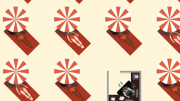As a kid, visiting the Manitoba Museum (then known as the Manitoba Museum of Man and Nature) was always an adventure. There was the Polar Bear Cave, The Nonsuch and, if we were lucky, a quick visit downstairs to slide around in the mirror-laser room at “Touch the Universe.”
That first section of the gallery often got missed in the excitement to see the polar bear with its bloody and freshly-killed seal. However, as an adult I realized that this oversight was not merely the result of an adventure seeking and attention-deficient young mind. In fact, once you make it past the buffalo herd you can’t help but notice that the Earth history section consists mainly of old, faded text, out of date taxonomy and non-interactive displays. You stand there squinting, not only trying to find something (anything) of interest, but also trying to piece together which display goes with which text, until finally your brain is so tired that you just decide to give up and seek comfort with the old polar bear.
But all that has completely changed.
The new cretaceous life section of the “Earth History Gallery,” completely revamped, now contains interactive displays, videos, new fossil exhibits and a section on the asteroid-driven mass extinction that marked the end of the cretaceous period 65 million years ago, and killed not only the dinosaurs, but many other species as well. For someone who remembers the old, faded gallery, it is truly breathtaking.
A large, panoramic painting of life during the cretaceous period welcomes you to the age of dinosaurs, where you can not only touch a dinosaur bone, but look through a microscope to see the inside of one. A tyrannosaurus is feeding on a mosasaur that has washed ashore from the sea.
A few steps over is a skeletal mosasaur (an animal known as the “dinosaur of the sea”) who seems to have just spotted a succulent ammonite to devour and is heading single-mindedly after it. Different types of teeth are displayed under a movable magnifying glass next to descriptions of what they say about the types of prey these animals preferred. Molars are for grinding vegetable matter. A pterosaur flies overhead with a tasty catch in its jaws.
One of my favourite additions is a display containing fossil reconstructions. An ordinary fossil (which in some cases is no more than a simple, unassuming chunk of rock) stands next to a beautifully sculpted and vibrant rendition of what the animal might have looked like when alive. The fossils spring to life, as does the palaeontology enthusiast inside.
The exhibit on the mass extinction that occurred at the end of the cretaceous period is almost worth the trip in itself. It’s a serious education in fossil excavation, the process of science and mass extinctions in general. There’s also an interactive video, which is always fun.
With the cretaceous exhibit nearly finished, curator Graham Young turns his sights to other potential improvements. Underway is a large video panorama depicting life in the seas during the ordovician period 445 million years ago, where we’ll get to see “giant trilobites plough through the seafloor mud, while sea scorpions, fish-like conodont animals and huge, fierce predatory cephalopods swim above.” Speaking of giant trilobites, the world’s largest fossilized trilobite (discovered in Churchill, Man.) is also on display in this section of the museum. As we’re talking about an insect the size of a household cat here — it’s definitely worth seeing.
Do yourself a favour and check out the new and improved Earth history section at the Manitoba Museum. But be warned: by the time you get through this gallery, the polar bear might not seem all that interesting anymore.




